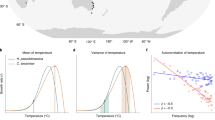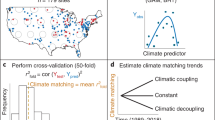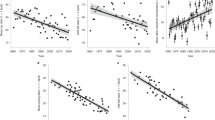Abstract
Large-scale climatic indices such as the North Atlantic Oscillation1 are associated with population dynamics2, variation in demographic rates3 and values of phenotypic traits4,5 in many species. Paradoxically, these large-scale indices can seem to be better predictors of ecological processes than local climate5,6,7,8. Using detailed data from a population of Soay sheep9,10, we show that high rainfall, high winds or low temperatures at any time during a 3-month period can cause mortality either immediately or lagged by a few days. Most measures of local climate used by ecologists fail to capture such complex associations between weather and ecological process, and this may help to explain why large-scale, seasonal indices of climate spanning several months can outperform local climatic factors. Furthermore, we show why an understanding of the mechanism by which climate influences population ecology is important. Through simulation we demonstrate that the timing of bad weather within a period of mortality can have an important modifying influence on intraspecific competition for food, revealing an interaction between climate and density dependence11 that the use of large-scale climatic indices or inappropriate local weather variables might obscure.
This is a preview of subscription content, access via your institution
Access options
Subscribe to this journal
Receive 51 print issues and online access
$199.00 per year
only $3.90 per issue
Buy this article
- Purchase on Springer Link
- Instant access to full article PDF
Prices may be subject to local taxes which are calculated during checkout


Similar content being viewed by others
References
Hurrell, J. W. Decadal trends in the North Atlantic Oscillation: Regional temperatures and precipitation. Science 269, 676–679 (1995)
Stenseth, N. C. et al. Ecological effects of climate fluctuations. Science 297, 1292–1296 (2002)
Coulson, T. et al. Age, sex, density, winter weather, and population crashes in Soay sheep. Science 292, 1528–1531 (2001)
Forchhammer, M. C., Clutton-Brock, T. H., Lindstrom, J. & Albon, S. D. Climate and population density induce long-term cohort variation in a northern ungulate. J. Anim. Ecol. 70, 721–729 (2001)
Post, E. & Stenseth, N. C. Climatic variability, plant phenology, and northern ungulates. Ecology 80, 1322–1339 (1999)
Catchpole, E. A., Morgan, B. J. T., Coulson, T. N., Freeman, S. N. & Albon, S. D. Factors influencing Soay sheep survival. Appl. Stat. 49, 453–472 (2000)
Mysterud, A., Stenseth, N. C., Yoccoz, N. G., Ottersen, G. & Langvatn, R. in The North Atlantic Oscillations. Climatic Significance and Environmental Impact (eds Hurrell, J. W., Belgrano, A., Ottersen, G. & Kushnir, Y.) 235–262 (American Geophysical Union, Washington DC, 2003)
Stenseth, N. C. et al. Studying climate effects on ecology through the use of climate indices: the North Atlantic Oscillation. El Nino Southern Oscillation and beyond. Proc. R. Soc. B. 270, 2087–2096 (2003)
Jewell, P. A., Milner, C. & Morton Boyd, J. Island Survivors: the Ecology of the Soay Sheep of St. Kilda (Academic, London, 1974)
Clutton-Brock, T. H. & Coulson, T. N. Ungulate population dynamics: the devil is in the detail. Phil. Trans. R. Soc. 357, 1299–1306 (2002)
Millonas, M. Fluctuations and Order. The New Synthesis (Springer, New York, 1995)
Elton, C. S. Periodic fluctuations in the number of animals: Their cause and effects. Br. J. Exp. Biol. 2, 119–163 (1924)
Nicholson, A. The balance of animal populations. J. Anim. Ecol. 2, 132–178 (1933)
Grenfell, B. T. et al. Noise and determinism in synchronised sheep dynamics. Nature 394, 674–677 (1998)
Turchin, P. Complex Population Dynamics: A Theoretical/Empirical Synthesis (Princeton Univ. Press, Princeton, 2003)
Post, E. & Stenseth, N. C. Large-scale climatic fluctuation and population dynamics of moose and white-tailed deer. J. Anim. Ecol. 67, 537–543 (1998)
Post, E. & Forchhammer, M. C. Synchronization of animal population dynamics by large-scale climate. Nature 420, 168–171 (2002)
Stenseth, N. C. et al. Dynamics of coastal cod populations: intra- and intercohort density dependence and stochastic processes. Proc. R. Soc. Lond. B 266, 1645–1654 (1999)
Albon, S. D., Guinness, F. E. & Clutton-Brock, T. H. The influence of climatic variation on the birth weights of red deer (Cervus elaphus). J. Zool. 200, 295–298 (1983)
Albon, S. D., Clutton-Brock, T. H. & Guinness, F. E. Early development and population dynamics in red deer. 2. Density independent effects and cohort variation. J. Anim. Ecol. 56, 69–81 (1987)
Gaillard, J. M. et al. Early survival in roe deer: causes and consequences of cohort variation in two contrasted populations. Oecologia 112, 502–513 (1997)
Keller, L. F. & Vannoordwijk, A. J. Effects of local environmental conditions on nestling growth in the great tit Parus major L. Ardea 82, 349–362 (1994)
Clutton-Brock, T. H. et al. Stability and instability in ungulate populations: An empirical analysis. Am. Nat. 149, 195–219 (1997)
Illius, A. W. & Gordon, I. J. in 38th Symposium of the BES. Herbivores. Between Plants and Predators (eds Oliff, H. & Drent, R. H.) (Blackwell Science, Oxford, 2002)
Milner, J. M., Elston, D. A. & Albon, S. D. Estimating the contributions of population density and climatic fluctuations to interannual variation in survival of Soay sheep. J. Anim. Ecol. 68, 1235–1247 (1999)
Clutton-Brock, T. H., Price, O. F., Albon, S. D. & Jewell, P. A. Early development and population fluctuations in Soay sheep. J. Anim. Ecol. 61–396 (1992)
Clutton-Brock, T. H. et al. Population fluctuations, reproductive costs and life history tactics in female Soay sheep. J. Anim. Ecol. 65, 675–689 (1996)
Gulland, F. M. D. The role of nematode parasites in Soay sheep (Ovis aries L) mortality during a population crash. Parasitology 105, 493–503 (1992)
Acknowledgements
For permission to work on St Kilda and logistics we thank Scottish Natural Heritage, the National Trust for Scotland and the UK Ministry of Defence. For data collection we thank A. MacColl and numerous volunteers. The long-term data collection has been funded by grants from NERC, BBSRC and the Wellcome Trust (UK) to T. Clutton-Brock, B. Grenfell, J. Pemberton and M. Crawley. We also thank I. Stevenson for installing and maintaining weather stations on Hirta, and to I. Stevenson and M. Crawley for comments on an earlier draft of the manuscript.
Author information
Authors and Affiliations
Corresponding author
Ethics declarations
Competing interests
The authors declare that they have no competing financial interests.
Rights and permissions
About this article
Cite this article
Hallett, T., Coulson, T., Pilkington, J. et al. Why large-scale climate indices seem to predict ecological processes better than local weather. Nature 430, 71–75 (2004). https://doi.org/10.1038/nature02708
Received:
Accepted:
Issue Date:
DOI: https://doi.org/10.1038/nature02708
This article is cited by
-
Demographic and external drivers of European hare (Lepus europaeus) population dynamics in western Poland from 1960 to 2009
European Journal of Wildlife Research (2024)
-
Organic carbon in British lowland ponds: estimating sediment stocks, possible practical benefits and significant unknowns
Hydrobiologia (2023)
-
Improved seasonal prediction of harmful algal blooms in Lake Erie using large-scale climate indices
Communications Earth & Environment (2022)
-
A global review of the critical link between river flows and productivity in marine fisheries
Reviews in Fish Biology and Fisheries (2022)
-
Breeding stage and tissue isotopic consistency suggests colony-level flexibility in niche breadth of an Arctic marine bird
Oecologia (2022)
Comments
By submitting a comment you agree to abide by our Terms and Community Guidelines. If you find something abusive or that does not comply with our terms or guidelines please flag it as inappropriate.



